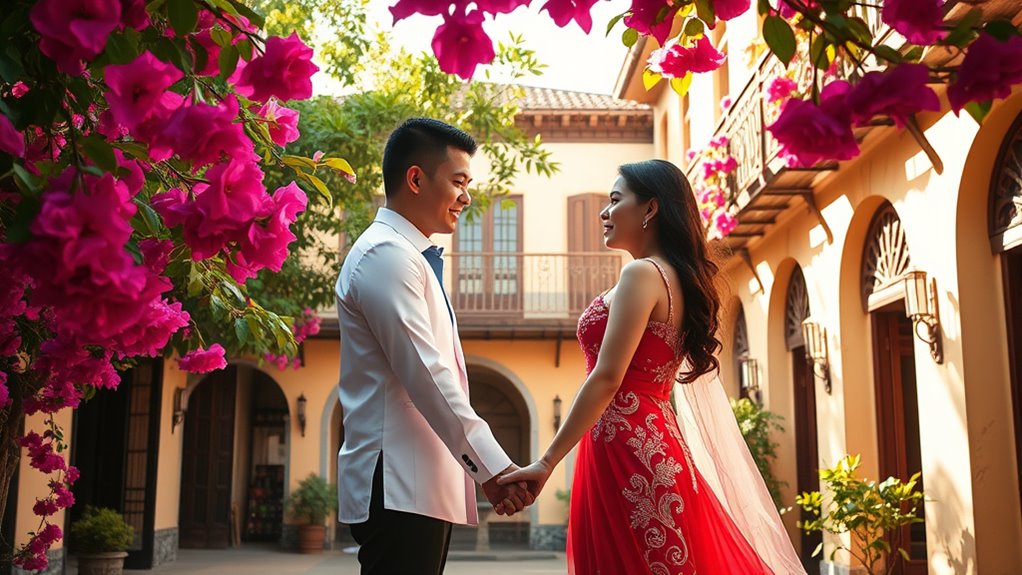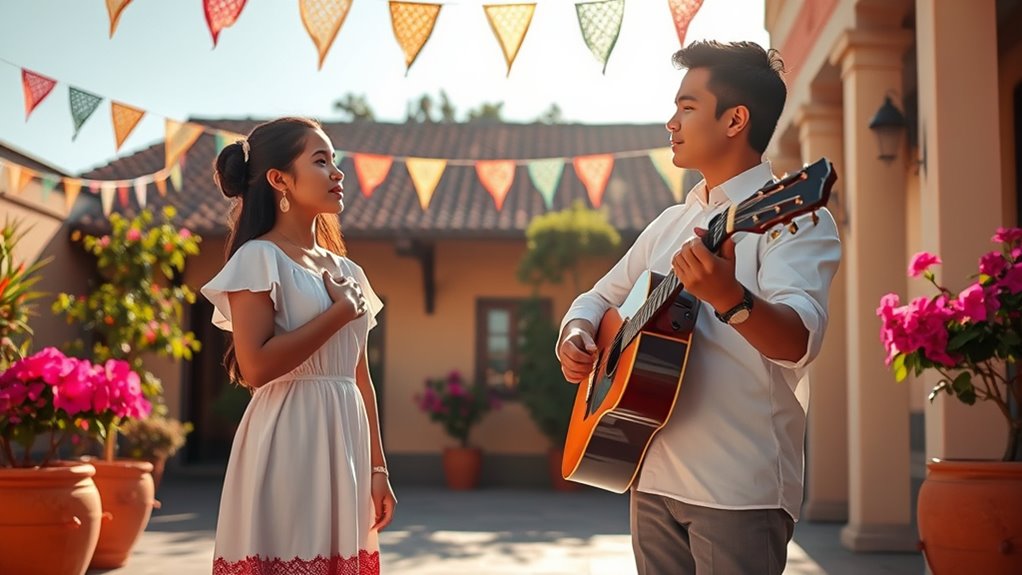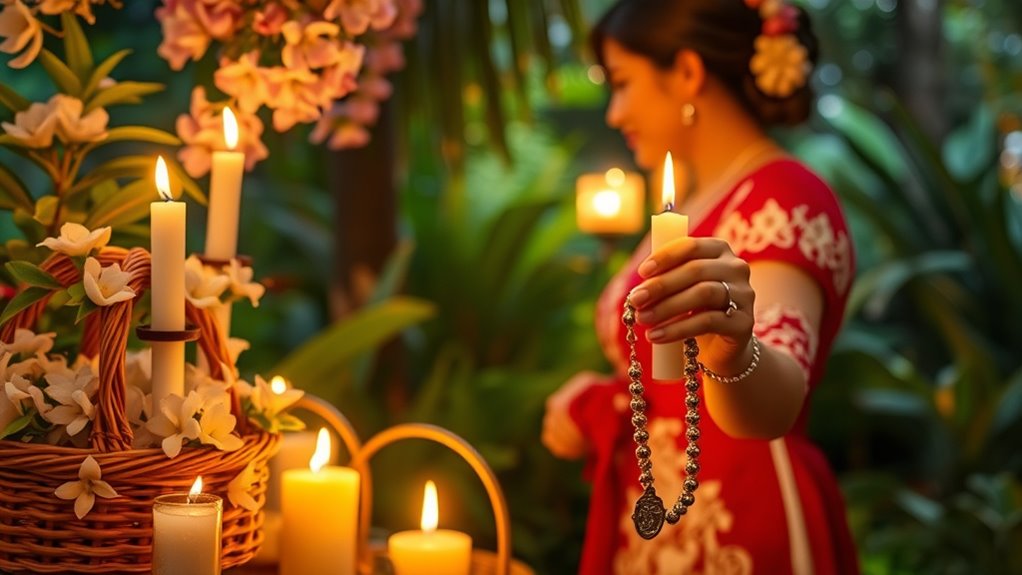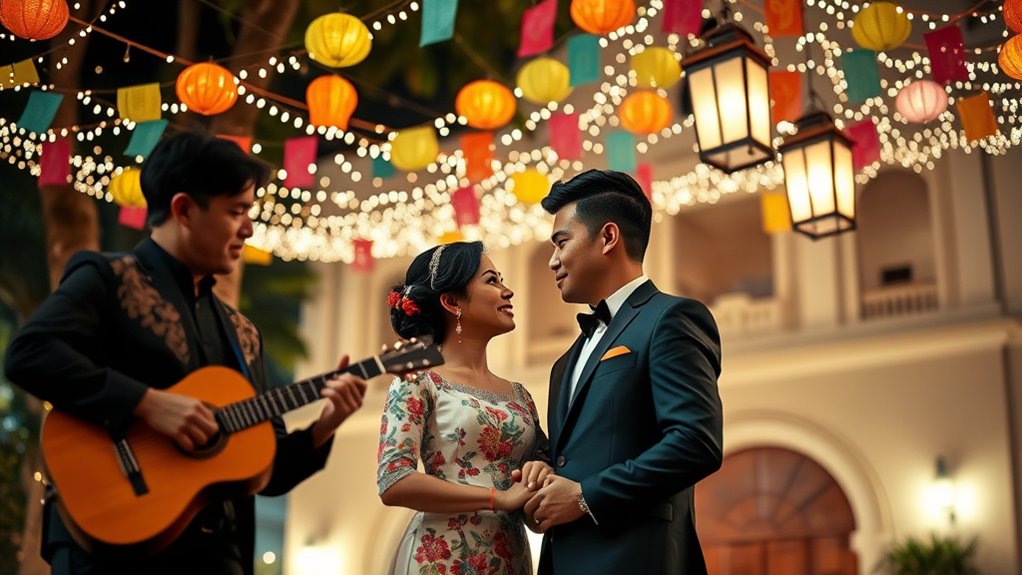Spanish culture has greatly influenced Filipina romance, shaping courtship rituals and emotional expressions. Think of the harana, a soulful serenade that emphasizes respect and commitment. Catholicism plays a role too, guiding values like respect and familial approval in partner selection. Modern adaptations, such as e-harana and online flirting, blend tradition with technology. If you’re curious about how these influences manifest in today’s relationships, there’s so much more to explore.
Key Takeaways
- Spanish colonial rule introduced courtship practices like harana, emphasizing respect and commitment in romantic relationships.
- The blending of Spanish and indigenous musical styles in kundiman reflects deep emotions in Filipina romance.
- Family involvement in partner selection stems from Spanish cultural values, affecting romantic decisions in the Philippines.
- E-harana modernizes traditional serenades, showcasing the adaptation of Spanish influences in contemporary courtship.
- Social media shapes perceptions of romance, with Spanish cultural elements still resonating in modern Filipino dating practices.
Historical Context of Spanish Influence in the Philippines

Although you may already know that Spanish influence in the Philippines began with Ferdinand Magellan’s arrival in 1521, the true impact unfolded over more than three centuries of colonization.
From 1565 to 1898, Spanish rule reshaped Filipino society fundamentally. Key figures like Miguel López de Legazpi established Manila as the colonial capital, facilitating the spread of Catholicism.
Spanish rule from 1565 to 1898 transformed Filipino society, with Manila emerging as a cultural and religious center under Miguel López de Legazpi.
The Spaniards imposed new social and economic structures, replacing traditional systems with the encomienda system and introducing a monetary system based on Spanish currency.
This cultural transformation also included linguistic influences, with around 20% of Tagalog words tracing back to Spanish.
As a result, the Philippines emerged with a unique blend of indigenous and Spanish cultures, laying the groundwork for modern Filipino identity.
The Evolution of Harana in Filipino Courtship

As you explore the evolution of harana, you’ll discover how this traditional Filipino courtship ritual reflects deep-rooted values of respect and commitment.
Originating during the Spanish colonial period, harana blends Spanish serenading traditions with Filipino customs, showcasing a unique expression of love. The serenader typically performs outside, respecting family boundaries, while emphasizing patience and loyalty.
In harana, the themes of longing and affection often intertwine with humor, creating a nuanced dialogue between suitor and beloved. The integration of kundiman further enriches this tradition, capturing deep emotions through heartfelt melodies.
Though modern times present challenges, efforts to revive harana highlight its significance as a cherished aspect of Filipino cultural heritage and courtship practices.
Musical Elements in Filipino Romance

Music plays an essential role in Filipino romance, acting as a powerful medium for expressing emotions and connecting lovers. Spanish culture introduced instruments like the guitar and violin, enriching the emotional depth of love songs. You’ll notice that melodies often blend Spanish melancholy with indigenous styles, enhancing the expressiveness of kundiman, a traditional Filipino love song. These slow, emotional songs, often in minor keys, convey deep longing and respect, emphasizing sincerity in courtship. Popular kundiman classics like “O Ilaw” and “Dahil Sa Iyo” are staples during serenades. Additionally, traditional Filipino music often incorporates indigenous ingredients, creating a rich tapestry of sound that reflects cultural heritage.
Modern Filipino love songs, influenced by the Manila Sound era, incorporate playful elements while reflecting evolving societal views on romance. This cultural fusion creates a unique and heartfelt musical landscape in Filipino romance. The emotional struggles portrayed in these songs often resonate with listeners, much like the experiences of individuals with BPD traits, highlighting the universal nature of love and longing.
The Role of Catholicism in Romantic Traditions

Catholicism shapes romantic traditions in the Philippines profoundly, influencing how relationships are formed and maintained. With around 80% of Filipinos identifying as Catholic, values like respect, modesty, and familial approval dominate courtship rituals.
You’ll find that these traditions promote lifelong monogamous relationships, contrasting with pre-colonial norms. Family involvement is essential; parents often guide romantic decisions, impacting partner selection. Public displays of affection are generally limited, fostering a reserved approach to romance.
Additionally, religious festivals like Fiesta serve as social platforms for romantic encounters, where couples strengthen community ties through shared activities. By participating in church events, you’ll create sacred moments that deepen emotional connections, making Catholic rituals integral to both engagement and marriage celebrations.
Literary Reflections of Spanish Influence on Love

Spanish influence on love in Philippine literature reveals a rich tapestry of emotions and complexities that resonate deeply with readers. You’ll find romantic themes in Hispano-Filipino works that mirror Spanish romances, showcasing conflicts between characters from diverse cultural backgrounds.
José Rizal’s *Noli Me Tángere* intricately weaves love with social issues, particularly through the character of María Clara, who embodies the struggle between duty and desire. Similarly, Francisco Baltazar’s *Florante at Laura* highlights love and heroism within a colonial framework.
The blending of Spanish literary forms with indigenous narratives enriches these romantic expressions, allowing authors to critique colonial rule while exploring personal relationships. Overall, literature becomes a powerful medium for expressing both love and national identity.
Fiestas as Expressions of Romance and Community

Romance in Filipino culture flourishes during fiestas, where love and community intertwine in vibrant celebrations. These events, rooted in Spanish traditions, provide you with opportunities to connect with others and express your feelings.
As you dance to traditional music and engage in lively activities, the festive atmosphere heightens romantic emotions. Fiestas aren’t just about individual relationships; they strengthen community bonds, reinforcing the importance of family ties in your romantic pursuits.
With each feast day honoring a patron saint, you participate in a shared cultural heritage that enriches your social life. Ultimately, fiestas symbolize love and commitment, making them essential in cultivating deeper relationships within your community. Additionally, these celebrations often foster emotional resilience, allowing individuals to cope with life’s challenges and embrace their romantic endeavors more fully.
Enjoy the energy, and let romance blossom during these cherished gatherings!
Modern Adaptations of Traditional Courtship Practices

As technology continues to reshape our lives, traditional courtship practices in the Philippines have evolved to embrace modern methods.
E-harana, or electronic serenades, now replace the classic serenade, allowing you to express affection through digital platforms. You can engage in online tuksuhan, teasing each other via text or social media to gauge interest. Additionally, couples who work together often report higher satisfaction in their relationships, further enhancing their romantic connections. This collaborative experience can lead to a stronger bond, aligning with the notion of community support that is vital for new families. Research shows that shared experiences can significantly improve relationship satisfaction. Regularly reflecting on shared experiences fosters a deeper understanding of each other’s needs and strengthens emotional ties.
E-harana and online tuksuhan modernize romance in the Philippines, blending tradition with digital expression of affection.
Love letters have changed to digital notes sent through messaging apps, maintaining that romantic touch. Family remains integral; parents stay informed through social media, and seeking their approval still matters.
With dating apps like Tinder and instant messaging, you can connect faster and more easily, blending the old customs with today’s conveniences. This fusion makes romance accessible while respecting deep-rooted cultural values. Additionally, understanding Filipino culture is essential for fostering genuine connections and navigating the complexities of cross-cultural romance.
Frequently Asked Questions
How Did Spanish Colonialism Affect Filipino Gender Roles in Romance?
Spanish colonialism greatly reshaped Filipino gender roles in romance.
You’ll notice that traditional dynamics shifted as patriarchal norms took hold, pushing men into dominant positions while women were often relegated to submissive roles.
Courtship became more formalized, focusing on family honor and reputation rather than personal connection.
This change not only altered how relationships formed but also set patterns that continue to influence your understanding of romance in contemporary Filipino society.
What Are Some Famous Filipino Love Stories Influenced by Spanish Culture?
When you explore famous Filipino love stories, you’ll encounter works like José Rizal’s “Noli Me Tángere” and “El Filibusterismo,” where romance intertwines with social critique.
You might also find modern films showcasing love against a backdrop of family ties and cultural celebrations.
Classics like “Florante at Laura” reflect deep emotional connections shaped by historical contexts.
These narratives highlight the enduring impact of cultural influences on love and relationships in the Philippines.
How Do Spanish Words Enhance Expressions of Love in Filipino?
Spanish words enhance your expressions of love in Filipino by adding emotional depth and a melodic quality.
When you use terms like “querida” or “amor,” you convey affection in a way that feels richer and more romantic. These words often evoke poetic imagery, making your sentiments resonate deeper.
As you blend these influences, your love expressions become a unique fusion, reflecting both passion and commitment that beautifully capture your feelings.
Are There Any Unique Filipino Love Rituals Stemming From Spanish Traditions?
You’ll find several unique Filipino love rituals that stem from Spanish traditions.
For instance, serenading, or *balak*, lets you express your affection through song. Gift-giving plays a vital role too, where you show respect not just to your love interest, but her family as well.
Another ritual, *paninilbihan*, involves you performing household tasks for her family, showcasing your dedication.
These customs blend romance with deep cultural significance, enriching the courtship experience.
How Is Harana Celebrated in Contemporary Filipino Culture Today?
Today, you might find harana celebrated through lively community events and festivals, like the Harana Festival in Cavite.
Local musicians blend traditional serenades with modern sounds, making it appealing to younger audiences.
Social media amplifies this revival, as people share their own harana experiences online.
While urbanization has shifted dating practices, the essence of harana remains, reminding you of the beauty of genuine connections and heartfelt gestures in romance.
Conclusion
In the rich tapestry of Filipino romance, the threads of Spanish influence weave a story that’s both timeless and evolving. From the serenades of harana to the vibrant fiestas, these traditions remind us that love, like culture, adapts yet endures. So, as you explore the enchanting dance of courtship, remember that every romantic gesture carries whispers of a shared history, inviting you to embrace the beauty of connection in your own life. Can you hear those whispers?









